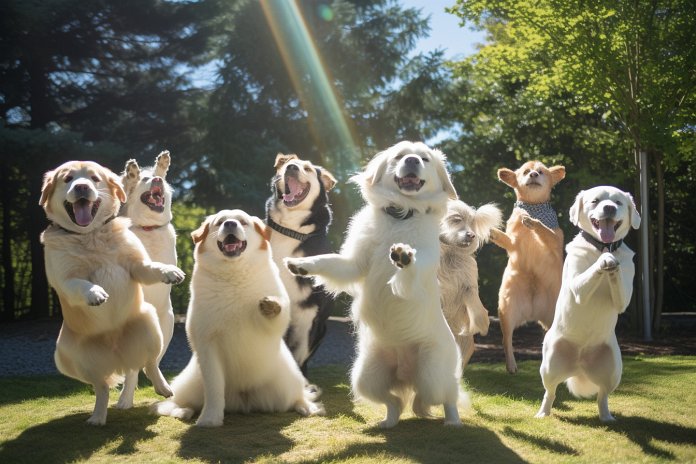
Do you and your dog love to dance? If so, Doggy Dancing might be the perfect sport for you. Also known as canine freestyle or musical canine freestyle, Doggy Dancing combines obedience training, tricks, and dancing. It’s a fun and challenging sport that requires training and practice.
Signs Your Dog Will Love Doggy Dancing
Not all dogs are suited for Doggy Dancing, but there are signs that indicate your dog might enjoy it. Look for these attributes:
1. They’re easy to train: If your dog responds well to rewards and is intelligent, they might be a good fit for Doggy Dancing.
2. They want to please you: Dogs that love having a job and making their owners happy are likely to enjoy Doggy Dancing.
3. They love spending time with you: Doggy Dancing requires time and effort, making it a great way to bond with your pet.
4. They’re active: Energetic dogs can benefit from Doggy Dancing as it provides an outlet for their excess energy.
Body Language and Other Signs
Pay attention to your dog’s body language for signs that they might enjoy Doggy Dancing, such as being alert, wagging their tail, head bobbing, and play bowing. Other signs include being easy to train, eager to please, having high energy levels, and loving to spend time with you.
The History of Canine Freestyle
Doggy Dancing has its origins in heelwork to music demonstrations that started in 1989. These demonstrations allowed handlers and dogs to be more creative and have fun compared to traditional obedience competitions. Canine freestyle clubs and associations formed in the 1990s, and the World Canine Freestyle Organization was established in 1999. The sport gained worldwide attention when Ashleigh and Pudsey won Britain’s Got Talent in 2012.
The Science of Doggy Dancing
Doggy Dancing encompasses two disciplines: canine freestyle and heelwork to music. Canine freestyle focuses on tricks and obedience skills, while heelwork to music involves dogs staying in the heel position while their handler moves to music. Dogs perform various choreographed moves, such as jumping, spinning, rolling over, and weaving between their handler’s legs. The key is the relationship between the dog and their handler.
Training Your Dog for Doggy Dancing
Training your dog for Doggy Dancing takes time and patience. Start with a strong foundation in obedience and gradually introduce more advanced tricks. Repetition, consistency, and rewards are essential. Remember to have fun and enjoy the process, as Doggy Dancing is all about building a strong bond with your pet.
“Dance like nobody’s watching, especially not your dog.”

Tips & Things to Know
1️⃣ Training and practice are key: Doggy Dancing is a fun and challenging sport, but it takes time and effort to become a fluent team. Commit to training and practicing regularly with your dog to improve your skills and bond with your pet.
2️⃣ Look for signs that your dog will enjoy Doggy Dancing: Dogs that are easy to train, eager to please, love spending time with you, and have high energy levels may be well-suited for this sport. Pay attention to your dog’s body language and behaviors to determine if they would enjoy dancing with you.
3️⃣ Start with a strong obedience foundation: If your dog is already well-trained in basic obedience commands, it will be easier to transition into canine freestyle. If not, work on developing those skills before moving on to more advanced tricks and routines. Patience, repetition, and consistency are key in training your dog for Doggy Dancing. Remember to have fun and enjoy the process with your furry friend.
Frequently Asked Questions, Answered ✅
1. What is Doggy Dancing and how does it combine obedience training and dancing?
Doggy Dancing, also known as canine freestyle or musical canine freestyle, is a dog sport that combines obedience training, canine tricks, and dancing. It involves choreographing routines with your dog, incorporating various tricks and obedience skills, all set to music.
2. What are some signs that suggest my dog will enjoy Doggy Dancing?
Some signs that indicate your dog might love Doggy Dancing include being easy to train, wanting to please you, enjoying spending time with you, and having high energy levels.
3. What is the history of Canine Freestyle?
Canine Freestyle originated in 1989 with demonstrations of heelwork to music in North America, England, and the Netherlands. Canine freestyle clubs and associations started forming in the 1990s, and the World Canine Freestyle Organization was established in 1999. The sport gained significant attention when Ashleigh and Pudsey won Britain’s Got Talent.
4. What is the difference between canine freestyle and heelwork to music?
Canine freestyle focuses on tricks and obedience skills, while heelwork to music involves dogs staying in variations of the heel position while the handler moves to music.
5. How should I train my dog for Doggy Dancing?
Training your dog for Doggy Dancing requires patience and starting with a strong foundation in obedience. It is important to start slowly, gradually introducing more advanced tricks and routines. Consistency, repetition, and rewards are key elements in the training process. The emphasis is on having fun and building a strong relationship with your dog.